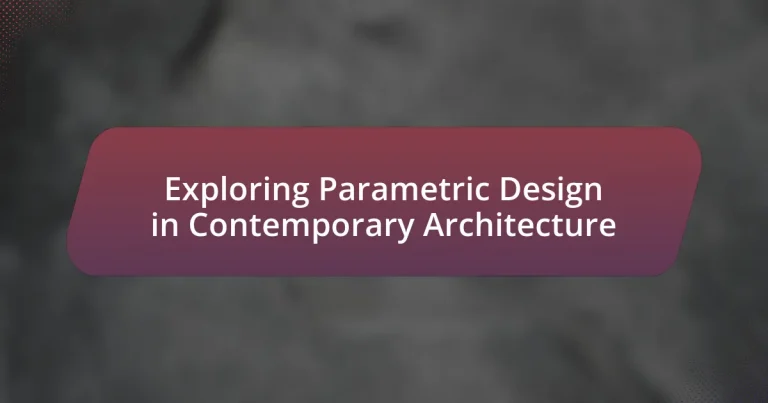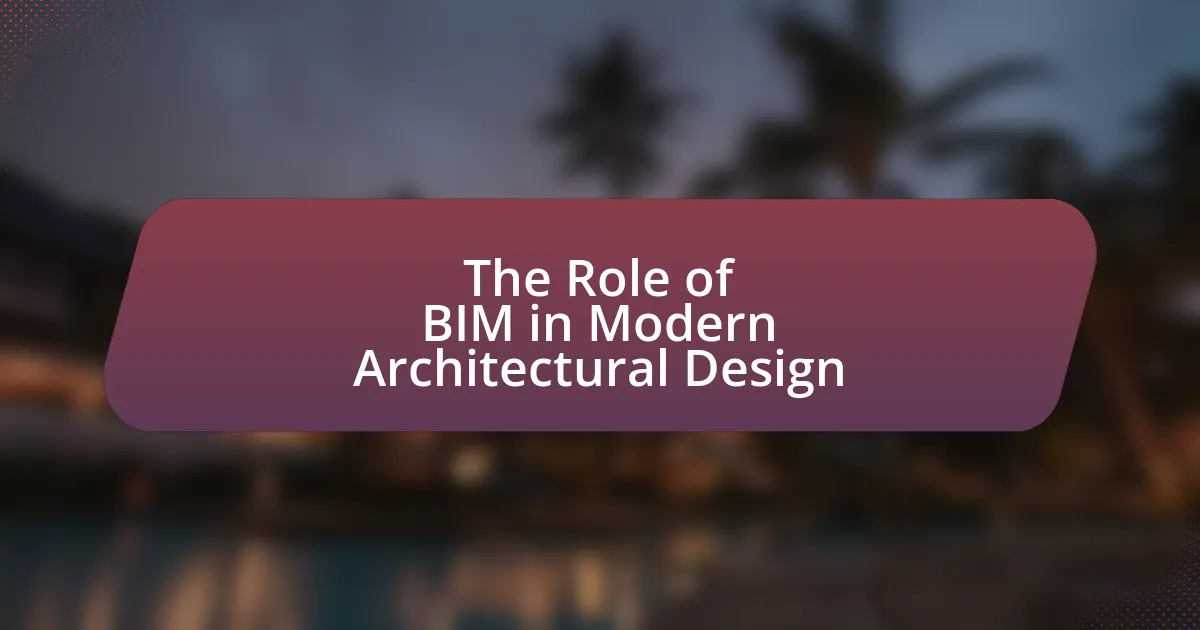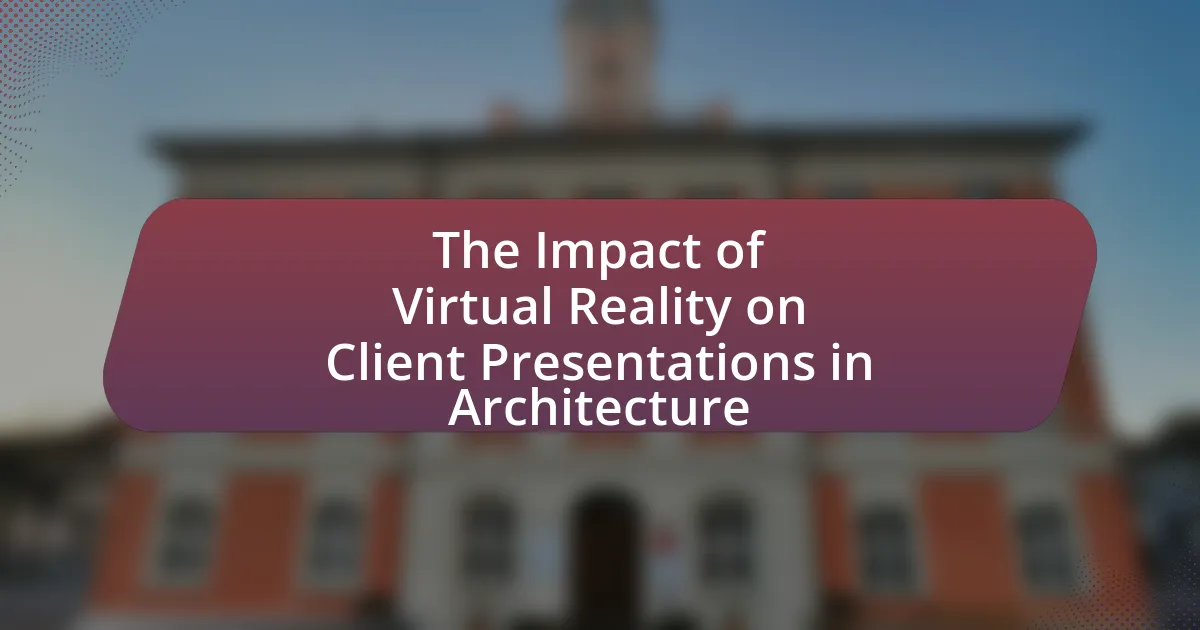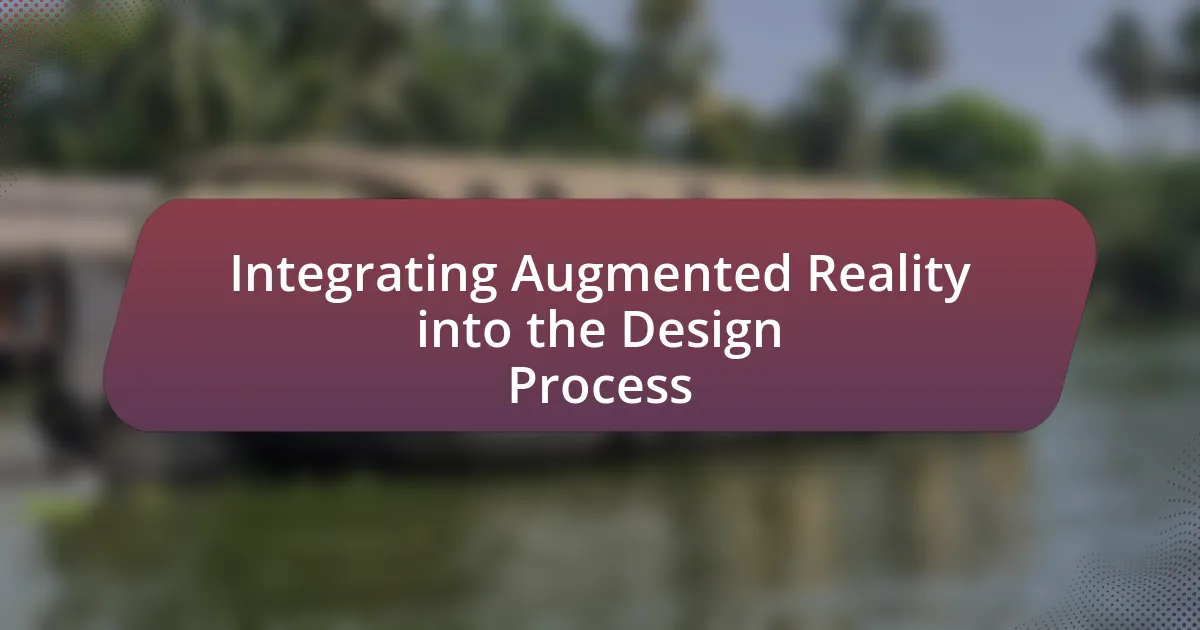Parametric design in contemporary architecture is a process that employs algorithmic thinking to define and manipulate design parameters, allowing for the creation of complex and adaptive structures. This approach contrasts with traditional design methods by utilizing computational tools, such as Rhino and Grasshopper, to generate intricate geometries and optimize performance based on various constraints. Key principles of parametric design include flexibility, adaptability, and the use of algorithms, which enhance creativity and innovation in architectural solutions. The article explores the significance of parametric design in addressing modern architectural challenges, its applications in urban planning, and its contributions to sustainability and structural engineering, while also discussing future trends and best practices for implementation.
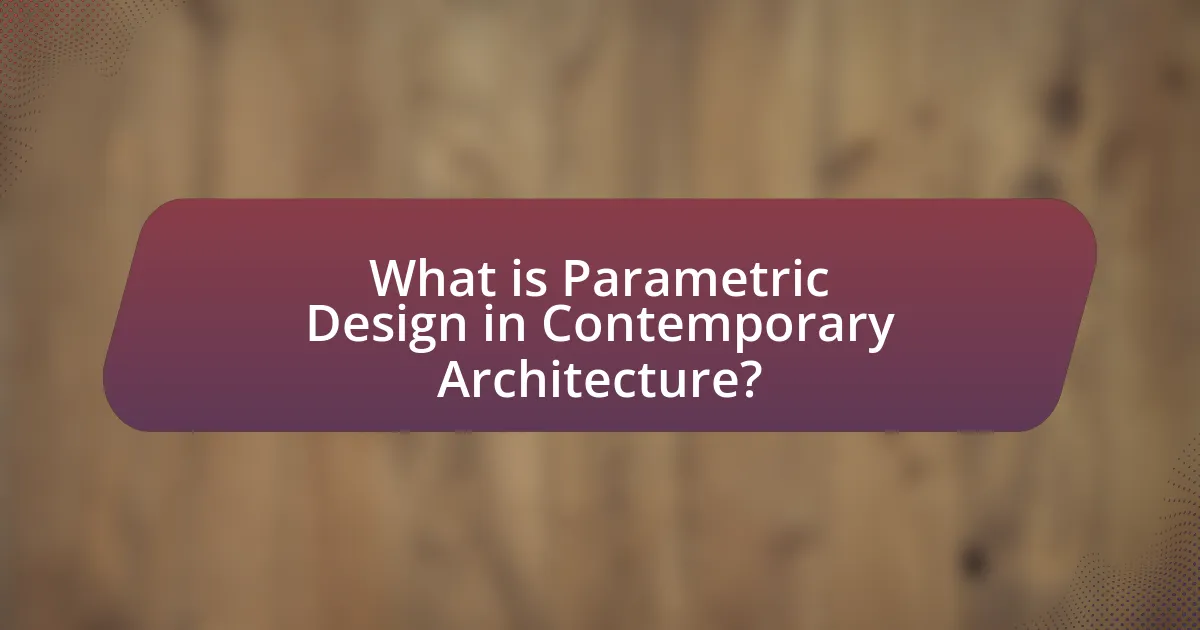
What is Parametric Design in Contemporary Architecture?
Parametric design in contemporary architecture refers to a design process that utilizes algorithmic thinking to define and manipulate the relationships between design parameters. This approach allows architects to create complex forms and structures that respond dynamically to various constraints and requirements, such as environmental factors, material properties, and user needs. The use of software tools, such as Rhino and Grasshopper, enables the generation of intricate geometries and optimized solutions, exemplified by projects like the Heydar Aliyev Center in Baku, designed by Zaha Hadid, which showcases the fluidity and adaptability inherent in parametric design.
How does Parametric Design differ from traditional design methods?
Parametric design differs from traditional design methods primarily in its use of algorithms and parameters to generate complex forms and structures. While traditional design relies on static, predefined shapes and manual drafting techniques, parametric design employs computational tools that allow designers to manipulate variables and relationships dynamically, resulting in adaptable and optimized solutions. This approach enables architects to explore a wider range of design possibilities and respond to specific performance criteria, as evidenced by projects like the Eden Project in the UK, where parametric modeling facilitated the creation of its intricate geodesic structures.
What are the key principles of Parametric Design?
The key principles of Parametric Design include flexibility, adaptability, and the use of algorithms to generate complex forms. Flexibility allows designers to modify parameters easily, enabling rapid iterations and exploration of design options. Adaptability ensures that designs can respond to changing conditions or requirements, enhancing functionality and performance. The use of algorithms facilitates the creation of intricate geometries and relationships between design elements, allowing for innovative solutions that traditional design methods may not achieve. These principles are foundational in contemporary architecture, as they enable architects to create responsive and efficient structures that meet diverse needs.
How does computational technology influence Parametric Design?
Computational technology significantly influences parametric design by enabling complex geometries and adaptive systems that respond to various parameters. This technology allows architects and designers to create intricate forms and structures that would be impossible to achieve through traditional design methods. For instance, software tools like Grasshopper and Rhino facilitate algorithmic design processes, allowing for real-time adjustments based on input variables such as material properties, environmental conditions, and user interactions. The integration of computational technology in parametric design has led to innovative architectural solutions, exemplified by projects like the Eden Project in the UK, where parametric modeling was essential for its geodesic dome structure.
Why is Parametric Design significant in contemporary architecture?
Parametric design is significant in contemporary architecture because it allows for the creation of complex forms and structures that respond dynamically to various parameters. This design approach utilizes algorithms and computational tools to manipulate design variables, enabling architects to explore a wider range of possibilities and optimize performance. For instance, projects like the Heydar Aliyev Center in Azerbaijan, designed by Zaha Hadid, exemplify how parametric design can lead to innovative and fluid architectural forms that would be difficult to achieve through traditional methods. Additionally, parametric design enhances sustainability by allowing for the simulation of environmental factors, leading to more efficient energy use and material consumption in buildings.
What challenges does Parametric Design address in modern architecture?
Parametric Design addresses several challenges in modern architecture, including complexity in form generation, optimization of material usage, and adaptability to site conditions. By utilizing algorithms and computational tools, architects can create intricate designs that would be difficult to achieve through traditional methods. For instance, Parametric Design allows for the optimization of structural performance, reducing material waste by analyzing load distribution and environmental factors. Additionally, it enables designs to be responsive to changing conditions, such as climate and user needs, enhancing functionality and sustainability in architectural projects.
How does Parametric Design enhance creativity and innovation?
Parametric design enhances creativity and innovation by allowing architects and designers to manipulate complex variables and relationships within their projects. This approach enables the exploration of a vast range of design possibilities, as it utilizes algorithms to generate forms and structures that would be difficult to conceive through traditional methods. For instance, the use of parametric tools like Grasshopper in Rhino allows for real-time adjustments, fostering an iterative design process that encourages experimentation and adaptation. This flexibility leads to unique architectural solutions that respond dynamically to environmental factors, user needs, and aesthetic preferences, ultimately pushing the boundaries of conventional design.
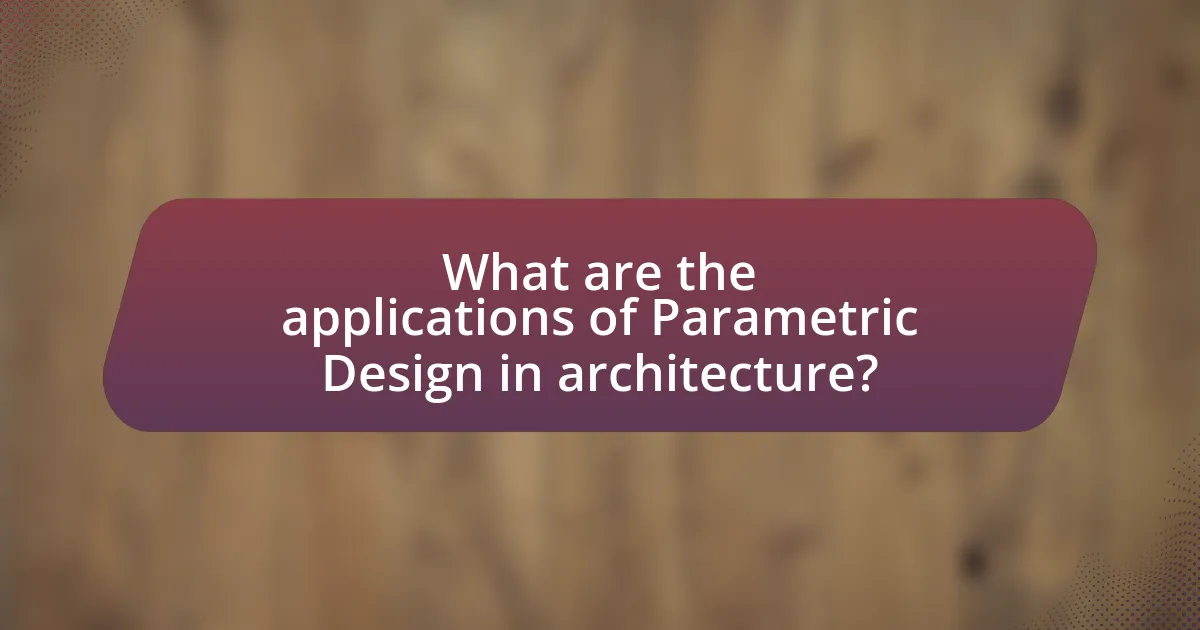
What are the applications of Parametric Design in architecture?
Parametric design in architecture is applied in various ways, including form generation, optimization of structural performance, and customization of building components. This design approach allows architects to create complex geometries that respond to specific environmental and functional requirements. For instance, the Eden Project in the UK utilizes parametric design to optimize the geodesic dome structures for energy efficiency and natural ventilation. Additionally, parametric tools enable rapid prototyping and iterative design processes, facilitating the exploration of multiple design alternatives quickly. The use of software like Grasshopper and Rhino has become prevalent, allowing for real-time adjustments based on parameters such as light, wind, and material properties, thus enhancing the overall design efficiency and sustainability in contemporary architecture.
How is Parametric Design utilized in urban planning?
Parametric design is utilized in urban planning to create adaptable and efficient spatial configurations that respond to various environmental, social, and economic factors. This design approach allows planners to manipulate parameters such as land use, population density, and infrastructure to optimize urban layouts. For instance, the use of parametric tools enables the simulation of different scenarios, facilitating data-driven decision-making that enhances sustainability and livability in urban environments. Studies have shown that cities employing parametric design methodologies can achieve improved resource management and reduced environmental impact, as evidenced by projects like the Masdar City in Abu Dhabi, which integrates advanced modeling techniques to minimize energy consumption and maximize green spaces.
What are some notable examples of Parametric Design in urban environments?
Notable examples of parametric design in urban environments include the Eden Project in the UK, the Beijing National Stadium, and the High Line in New York City. The Eden Project, designed by Sir Nicholas Grimshaw, utilizes a geodesic dome structure that adapts to environmental conditions, showcasing how parametric design can create sustainable ecosystems. The Beijing National Stadium, known as the Bird’s Nest, features a complex steel structure designed by Herzog & de Meuron, which was generated through parametric modeling to optimize both aesthetics and structural integrity. The High Line, designed by James Corner Field Operations and Diller Scofidio + Renfro, transformed an elevated railway into a public park using parametric design principles to create a fluid, organic landscape that integrates with the urban fabric. These projects exemplify how parametric design can enhance functionality, sustainability, and aesthetic appeal in urban settings.
How does Parametric Design contribute to sustainable architecture?
Parametric design contributes to sustainable architecture by enabling the optimization of building performance through data-driven modeling. This design approach allows architects to analyze various environmental factors, such as sunlight, wind patterns, and material efficiency, leading to structures that minimize energy consumption and resource waste. For instance, a study published in the journal “Sustainable Cities and Society” demonstrated that parametric design techniques can reduce energy use in buildings by up to 30% by optimizing form and orientation based on site-specific conditions. This integration of computational tools in the design process fosters innovative solutions that align with sustainability goals, ultimately resulting in more efficient and environmentally friendly architectural outcomes.
What role does Parametric Design play in structural engineering?
Parametric design plays a crucial role in structural engineering by enabling the creation of complex geometries and optimizing structural performance through algorithmic processes. This design approach allows engineers to manipulate parameters and constraints, leading to innovative solutions that enhance efficiency and sustainability. For instance, the use of parametric modeling software, such as Rhino and Grasshopper, facilitates real-time analysis and adjustments, ensuring that structures meet specific performance criteria while minimizing material usage. This capability is evidenced by projects like the Eden Project in the UK, where parametric design contributed to the efficient use of materials and energy, demonstrating its significant impact on modern structural engineering practices.
How does Parametric Design improve structural performance?
Parametric design improves structural performance by enabling the optimization of material usage and structural forms through computational algorithms. These algorithms allow architects and engineers to analyze various design parameters, such as load distribution and material properties, leading to more efficient and resilient structures. For instance, a study by K. K. Choi and J. H. Kim in the “Journal of Building Performance” demonstrated that parametric design techniques can reduce material consumption by up to 30% while maintaining structural integrity, showcasing the effectiveness of this approach in enhancing performance.
What software tools are commonly used in Parametric Design for structural applications?
Commonly used software tools in Parametric Design for structural applications include Rhino with Grasshopper, Autodesk Revit, and Tekla Structures. Rhino, combined with Grasshopper, allows for advanced geometric modeling and parametric control, making it a favorite among architects and engineers for creating complex structures. Autodesk Revit is widely utilized for Building Information Modeling (BIM), enabling users to design with parametric components that adapt to changes in the model. Tekla Structures specializes in structural engineering and offers robust tools for detailing and managing steel and concrete structures, supporting parametric workflows. These tools are integral to modern architectural practices, facilitating innovative design solutions and efficient project delivery.

What are the future trends in Parametric Design within architecture?
Future trends in parametric design within architecture include increased integration of artificial intelligence, enhanced sustainability practices, and greater customization capabilities. The use of AI algorithms will enable architects to generate complex forms and optimize designs based on performance metrics, leading to more efficient structures. Additionally, sustainability will be prioritized through parametric tools that analyze environmental impacts and material usage, promoting eco-friendly designs. Customization will also advance, allowing for tailored solutions that meet specific client needs and site conditions, facilitated by advancements in digital fabrication technologies. These trends reflect a shift towards more responsive, efficient, and personalized architectural practices.
How is artificial intelligence shaping the future of Parametric Design?
Artificial intelligence is significantly shaping the future of parametric design by enhancing computational capabilities and enabling more complex design iterations. AI algorithms can analyze vast datasets to identify patterns and optimize design parameters, leading to innovative architectural solutions that were previously unattainable. For instance, AI-driven generative design tools allow architects to explore numerous design alternatives quickly, improving efficiency and creativity in the design process. Research by Autodesk demonstrates that generative design can produce up to 100 design options in the time it takes to create one traditional model, showcasing the transformative impact of AI on parametric design methodologies.
What potential advancements can we expect in Parametric Design technology?
Potential advancements in Parametric Design technology include enhanced computational algorithms, improved integration with artificial intelligence, and increased interoperability with various software platforms. Enhanced computational algorithms will allow for more complex and efficient design solutions, enabling architects to explore a wider range of design possibilities. The integration of artificial intelligence can facilitate real-time design adjustments based on user input and environmental data, leading to more responsive and adaptive architectural solutions. Furthermore, increased interoperability among software platforms will streamline workflows, allowing for seamless collaboration between different design tools and disciplines. These advancements are supported by ongoing research and development in computational design, as seen in projects like the MIT Media Lab’s work on generative design, which demonstrates the potential for more innovative and efficient design processes.
How might Parametric Design evolve in response to environmental challenges?
Parametric Design may evolve by integrating advanced computational algorithms that optimize resource use and minimize environmental impact. This evolution will likely involve the incorporation of real-time data analytics to assess environmental conditions, enabling designs that adapt to climate variations and resource availability. For instance, projects like the Eden Project in the UK demonstrate how parametric tools can create structures that respond dynamically to their ecological context, optimizing energy efficiency and sustainability. As environmental challenges intensify, the demand for adaptive, resilient architectural solutions will drive further innovation in parametric methodologies, ensuring that designs not only meet aesthetic and functional requirements but also contribute positively to their ecosystems.
What best practices should architects follow when implementing Parametric Design?
Architects should prioritize clear objectives and constraints when implementing Parametric Design to ensure effective outcomes. Establishing specific design goals allows architects to create algorithms that respond accurately to parameters, leading to optimized solutions. Additionally, architects should utilize iterative testing and feedback loops throughout the design process, as this approach enhances adaptability and refinement of designs based on real-time data. Furthermore, collaboration with multidisciplinary teams is essential, as it fosters diverse perspectives and expertise, enriching the design process. Lastly, architects must invest in continuous learning and stay updated with advancements in software and computational techniques, which is crucial for leveraging the full potential of Parametric Design.
How can architects effectively collaborate with computational designers?
Architects can effectively collaborate with computational designers by establishing clear communication channels and integrating their workflows early in the design process. This collaboration allows architects to articulate their design intentions while computational designers can translate these ideas into parametric models, enhancing design efficiency and innovation. For instance, a study by KieranTimberlake in 2017 demonstrated that interdisciplinary teams, which included architects and computational designers, produced more creative solutions and reduced project timelines by 30% through effective collaboration. This evidence underscores the importance of shared goals and mutual understanding in achieving successful outcomes in parametric design.
What common pitfalls should be avoided in Parametric Design projects?
Common pitfalls to avoid in Parametric Design projects include overcomplicating the design process, neglecting user experience, and failing to validate design assumptions. Overcomplication can lead to inefficiencies and difficulties in implementation, as seen in projects where excessive parameters resulted in convoluted models that were hard to manage. Neglecting user experience can result in designs that, while innovative, do not meet the needs of end-users, as evidenced by studies showing that user-centered design significantly enhances project success. Lastly, failing to validate design assumptions can lead to costly errors; for instance, projects that did not test their parametric models against real-world conditions often faced significant redesigns, highlighting the importance of iterative testing and validation in the design process.
